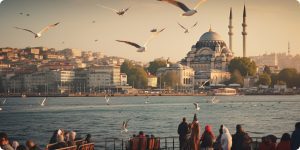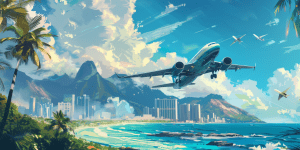From North to South
Content
- Starting Point: The Rugged North
- The Heartland: Madrid and Nature Trails
- The Enchanting South: From Sierra to Sea
- The Island Escape
- FAQ
While many flock to popular destinations and sights like Barcelona’s Sagrada Família or Madrid and its Prado Museum, Spain holds secret spots that remain largely untouched by tourist crowds. For those with a spirit of adventure and a desire to engage actively with their surroundings, traveling in Spain promises an unforgettable journey. In this guide, we’ll explore how to get to some of Spain’s unusual destinations.
Read article Culinary Journey through Spanish Desserts
Starting Point: The Rugged North
The north of Spain, with its dramatic coastlines, lush greenery, and imposing mountains, is paradise for the traveler.
The Basque Country's Coastal Walks
The Basque Country, known for its distinct culture and gastronomy, also boasts stunning coastal walks that reveal the dramatic beauty of Spain’s northern coastline. The Flysch Route in Zumaia is a standout, offering hikers breathtaking views of cliffs formed over millions of years, creating a natural geological museum.
Exploring The Flysch Route
Starting Point: The adventure begins at the Itzurun Beach in Zumaia, easily accessible and well-marked for visitors. The best times to visit are during the spring and fall when the weather is mild, and the natural beauty of the area is at its peak.
As you trek along the Flysch Route, the path unfolds along the coastline, offering breathtaking views of towering cliffs that drop dramatically into the Bay of Biscay. The striking contrast between the lush green landscape and the deep blue sea creates a photographer’s paradise. The route is dotted with vantage points that allow travelers to appreciate the intricate patterns and folds of the flysch formations, revealing millions of years of Earth’s history etched into the rocks.
The route concludes in the picturesque town of Deba, where visitors can relax in local cafes, visit exhibitions detailing the geological significance of the area, or simply enjoy the tranquil beauty of the Basque Country’s coastline.
Getting There: Driving from Bilbao to Zumaia is one of the most convenient ways to reach the town, offering the flexibility to explore the region at your own pace. The journey takes approximately 1 hour and 15 minutes, covering a distance of around 75 kilometers
The Guggenheim Museum, Bilbao
https://www.guggenheim-bilbao.eus/en
The Guggenheim Museum in Bilbao is a modern architectural marvel, designed by Frank Gehry. Its titanium-clad curves shimmer beside the Nervión River, creating a futuristic landscape in the heart of the Basque Country. The museum’s collection focuses on contemporary art, but it’s the building itself that has become an icon of modern architecture and transformed Bilbao into a cultural destination.
Just a short distance from the urban sophistication of the Guggenheim, the Basque coastline offers some of Europe’s best surfing spots. Mundaka, renowned for its perfect left-breaking barrel waves, is a paradise for surfers. Whether you’re an experienced surfer or a beginner eager to catch your first wave, the beaches around Bilbao provide a stunning backdrop for aquatic adventure.
Getting There: Bilbao’s international airport is just a short bus ride from the city center, offering flights to major cities in Spain and Europe. The city is also reachable by train or bus from other Spanish destinations, making it an accessible stop on a northern Spain tour.
Asturias: Kayaking and Canoeing
Asturias, a region where the mountains meet the sea, offers a unique opportunity to explore its landscapes via the Sella River. Kayaking or canoeing down this river, you’ll find yourself surrounded by the verdant landscapes of northern Spain.
The crown jewel of Asturias’s waterways, the Sella River, is famed for hosting the International Descent of the Sella, an annual event that draws enthusiasts from across the globe. With stretches that suit beginners and challenge the seasoned, the Sella offers a dynamic paddling experience amidst stunning landscapes.
https://www.descensodelsella.com/
Getting There: The drive from Oviedo to Arriondas is straightforward – 50 minutes via the A-64 and AS-260. This route offers scenic views of the Asturias countryside.
Cantabria: Mountain Biking in the Picos de Europa
The Picos de Europa National Park in Cantabria is a haven for mountain bikers. With trails that range from easy rides through meadows to challenging mountain passes, there’s something for every level of cyclist. The breathtaking views of the Cantabrian Mountains serve as a constant companion, making every pedal worthwhile.
https://parquenacionalpicoseuropa.es/english/plan-your-visit/
Bikers are treated to a mix of steep ascents, thrilling descents, and flat stretches, all while surrounded by the park’s unparalleled natural beauty. Popular routes are Fuente Dé to Sotres, Cares Gorge Circuit, Covadonga Lakes Loop
The Heartland: Madrid and Nature Trails
Moving southward, the heartland of Spain offers a mix of urban and rural active experiences.
The Charm of Rioja’s Vineyards
Rioja’s allure lies in its diverse terrain, from arid plains to lush valleys, all blessed with a climate that’s as varied as it is perfect for viticulture. The Ebro River carves through the region, nurturing the land with its life-sustaining waters, creating a microcosm where the Tempranillo grape, among others, thrives. These vineyards are not just agricultural estates; they are the soul of Rioja, encapsulating centuries of tradition, innovation, and passion for winemaking.
Camino del Vino
A trail as rich in beauty as it is in history, the Camino del Vino winds through the heart of the region. It offers walkers a glimpse into the ancient world of Riojan winemaking, with stops at medieval villages and centuries-old wineries. The path tells a story of a time when wine was as much a part of life as the air they breathed.
Getting There: For international visitors, the most convenient entry point is through the Bilbao Airport, located approximately 1.5 hours by car from the heart of La Rioja
Madrid: Urban Running
While many choose to explore this magnificent city through traditional tours, an increasingly popular way to discover Madrid’s charm is through urban running tours. This unique blend of sightseeing and exercise offers an exhilarating experience that combines the joy of running with the discovery of new places.
https://www.tripadvisor.com/Attractions-g187514-Activities-c61-t221-Madrid.html
An early morning run in Madrid can feel like a private viewing of the city’s architectural marvels, from the grand Royal Palace to the bustling Plaza Mayor and the serene Retiro Park. Running tours guide you through these landmarks, narrating the city’s history, making every kilometer a story.
If you like marathons, you can take part in the Mapoma Corre por Madrid in September. The distance is 10km, comfortable for beginners.
Castilla y León: Horseback Riding Adventures
The expansive landscapes of Castilla y León, steeped in history and dotted with castles, invite exploration on horseback, offering a connection to Spain’s equestrian traditions and the rugged beauty of its countryside.
Routes Through the Countryside: The region offers numerous trails that meander through medieval villages, alongside ancient aqueducts, and across vast plains. Whether you’re an experienced rider or trying horseback riding for the first time, the varied terrain of Castilla y León caters to all levels.
https://www.tripadvisor.com/Attractions-g187490-Activities-c61-t62-Castile_and_Leon.html
One of the most enchanting experiences is riding through the Sierra de Gredos, a mountain range that offers stunning vistas and challenging trails. Local farms and equestrian centers offer guided tours, ensuring a safe and memorable journey through the heart of Spain.
The Enchanting South: From Sierra to Sea
Andalusia: Hiking the Sierra Nevada
The Sierra Nevada in Andalusia presents a dramatic shift from the coastal serenity to rugged mountainous terrains, offering hikers an array of trails that range from serene walks to challenging treks.
Among these, the ascent to Mulhacén, the highest peak in mainland Spain, stands as a beacon for trekkers. The journey to its summit is filled with breathtaking views of rugged landscapes, verdant valleys, and, on clear days, a glimpse of the Mediterranean Sea and even the Moroccan Atlas Mountains. The route through the Poqueira Gorge combines natural beauty with the charm of quaint villages, providing a balanced experience of Andalusia’s diverse offerings.
The best times to visit the Sierra Nevada for hiking are late spring and early autumn when the temperatures are moderate, and the landscape is alive with colors. Winter transforms the peaks into a playground for snow sports, showcasing the region’s year-round appeal.
Tarifa: The Windsurfing Capital of Europe
At the southernmost tip of Spain, Tarifa is a confluence of the Mediterranean and the Atlantic, a city where the winds are as famous as its historical landmarks. Known as the European capital of windsurfing and kitesurfing, Tarifa’s beaches are a magnet for enthusiasts of these sports.
The unique geographical conditions in Tarifa create consistent winds that make it an ideal spot for windsurfing and kitesurfing. Beginners can take lessons at one of the many schools along the beach, while seasoned surfers can challenge themselves against the strong Levante and the more forgiving Poniente winds. Beyond the thrill of the sports, the beaches of Tarifa are gathering spots where cultures mingle, and the spirit of adventure thrives.
The Island Escape. Tenerife, Canary Islands
Tenerife, the largest of the Canary Islands, is a microcosm of unparalleled natural beauty and diversity, making it a perfect destination for active travelers seeking adventure amidst breathtaking landscapes.
Beyond the natural attractions, Tenerife’s culture adds another layer to the travel experience. The island’s festivals, such as the famous Carnival of Santa Cruz, blend traditional Canarian culture with a spirit of celebration. Additionally, Tenerife’s culinary scene offers a taste of local ingredients and dishes, from fresh seafood to papas arrugadas (wrinkly potatoes) with mojo sauce.
Paragliding offers an exhilarating way to view the island’s diverse landscapes from above. Tenerife’s unique topography and winds make it one of the best places in Europe for paragliding.
From tandem flights for beginners to advanced thermal flying for experienced pilots, Tenerife caters to all levels. Launch sites are scattered across the island, including popular spots like Taucho and Ifonche, offering views of the rugged coastline, verdant valleys, and the towering presence of El Teide.
Getting There: Regular ferry services connect Tenerife with the other Canary Islands and mainland Spain. Tenerife South Airport is the primary entry point for international travelers.
Ibiza, Balearic Islands
Ibiza, one of the jewels of the Balearic Islands, offers a kaleidoscope of experiences, transcending its global reputation as a party haven. Beyond the pulsating nightlife lies an island of serene beauty, characterized by idyllic beaches, crystal-clear waters, and lush countryside. Ibiza’s charm is in its diversity—from the UNESCO World Heritage-listed Dalt Vila, the old town of Ibiza City, to the secluded coves and pine-clad hills that dot the landscape.
While Ibiza’s clubs and bars are world-famous, the island is also a paradise for lovers of the great outdoors. Water sports enthusiasts can indulge in scuba diving, snorkeling, and paddleboarding in the clear Mediterranean waters, exploring marine life and underwater caves. For those who prefer to stay on land, Ibiza offers numerous hiking and biking trails that meander through its scenic countryside, revealing ancient watchtowers, rustic farms, and panoramic views of the coastline.
Surfing, though less associated with Ibiza compared to other activities, is available for those willing to seek it out, especially during the winter months when the island’s beaches, such as Cala Nova and Aguas Blancas, catch swell.
Getting There: The primary method for reaching Ibiza is by air. Ibiza Airport (IBZ) is well-connected, receiving flights from major cities across Europe and Spain, making it an accessible destination for international and domestic travelers alike.
FAQ
What is the best time of year to visit Spain?
For milder weather and fewer crowds, consider visiting in the spring (March to May) or fall (September to November). Summers (June to August) are hot and busy, ideal for beach holidays and festivals. Winters are mild in the south, perfect for exploring cities without the heat.
Are there any cultural customs I should be aware of when visiting Spain?
Spanish culture values social interactions and meals are often long, leisurely affairs. Tipping is appreciated but not mandatory, with rounding up the bill or leaving 5-10% in restaurants being customary. Siesta (afternoon break) is observed in some areas, meaning shops may close in the afternoon.
Is tap water safe to drink in Spain?
Yes, tap water is generally safe to drink throughout Spain. However, taste and mineral content can vary by region. If you prefer, bottled water is widely available.
For traveling between cities, use GetTransfer.com:
From Bilbao to Zumaia (~76 km) – economy $93, comfort $112, van $147, minibus $126
From Oviedo to Picos de Europa (~139 km) – economy $130, comfort $155, van $207, minibus $388
From Malaga to Tarifa (~151 km) – economy $132, comfort $159, van $204, minibus $398













